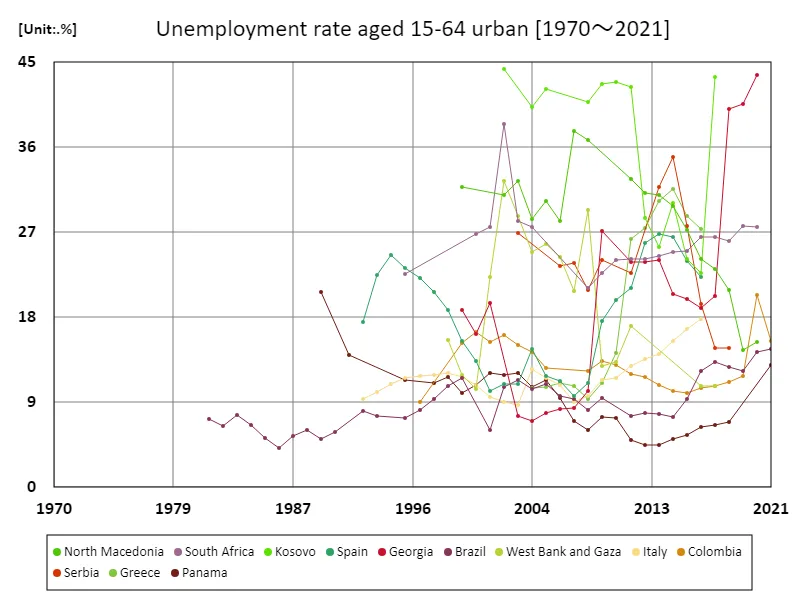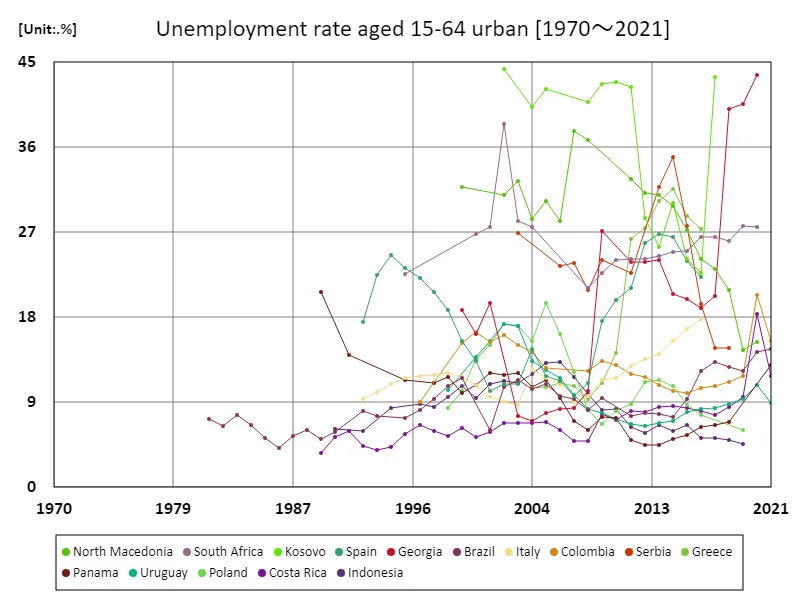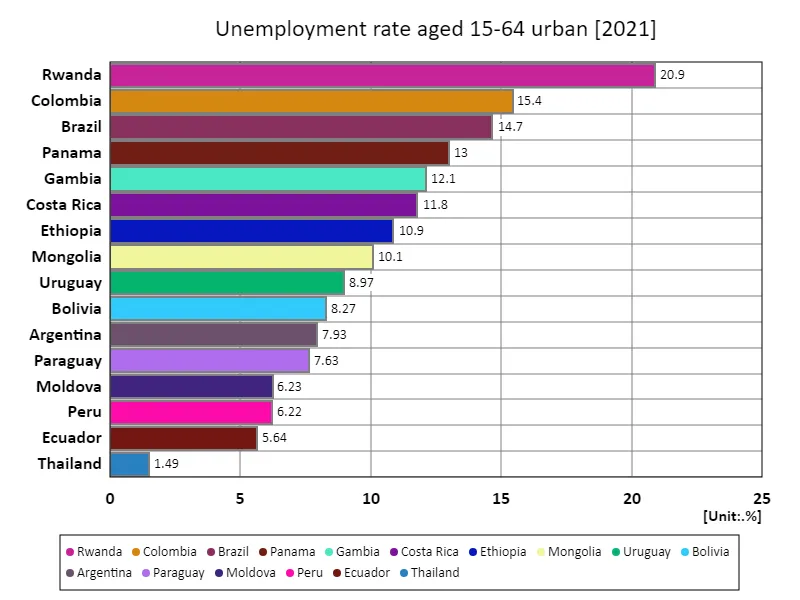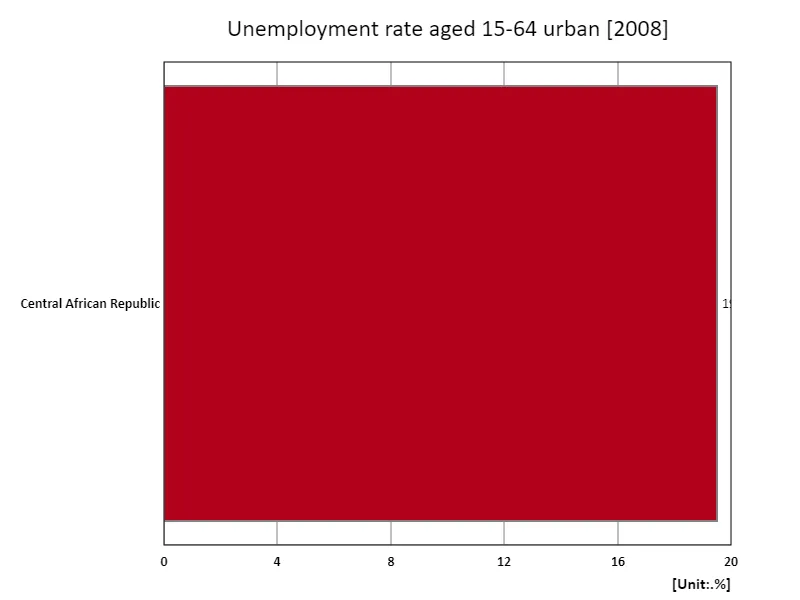- Abstract
- Unemployment rate for people aged 15-64, urban areas (percentage of total urban labor force)
- Unemployment rate in urban areas for people aged 15-64 (percentage of total urban labor force) (Worldwide)
- Unemployment rate in urban areas for people aged 15-64 (as a percentage of total urban labour force) (Worldwide, latest year)
- Unemployment rate for ages 15-64, urban areas (percentage of total urban labor force) (region, latest year)
- Reference
Abstract
Employment underemployment is a key indicator of the health of an economy and gives a clear picture of the state of the labor market, especially in urban areas. According to 2021 data, Colombia’s urban unemployment rate for people aged 15-64 is high at 15.4%, reflecting economic instability and the impact of the pandemic. Over the past few years, Colombia has seen a rise in informal employment, making stable employment difficult to obtain. In addition, the unemployment rate among young people is particularly high, and the lack of education and vocational training is a problem. On the other hand, with economic growth expected, companies will become more digitalized, which could create new employment opportunities. Going forward, policies that delve deeper into these trends and aim to create sustainable jobs are required.
Unemployment rate for people aged 15-64, urban areas (percentage of total urban labor force)
Looking at unemployment rate data from 1981 to 2021, the case of Kosovo in particular stands out. In 2002, the unemployment rate hit a staggering 44.3%, a major factor behind this was post-war economic recovery and political instability. In recent years, Kosovo has reduced its unemployment rate by 98.1% and it can be said that the economic situation is gradually stabilizing. Overall, unemployment rates fluctuated between the 1980s and 2000s as many countries experienced structural economic changes and the effects of globalization. Economic reforms and crisis situations directly led to unemployment, especially in Eastern European countries and South America. On the other hand, in recent years, there has been a trend towards increased employment opportunities in certain countries due to digitalization and the development of emerging industries. These data show how regional differences in economic conditions and policies affect unemployment rates, and highlight the need for labour market flexibility, education and skills development to create sustainable jobs. Improving unemployment rates requires a long-term strategy, and countries need to address that challenge.


The maximum is 44.3%[2002] of Kosovo, and the current value is about 98.1%
Unemployment rate in urban areas for people aged 15-64 (percentage of total urban labor force) (Worldwide)
Across the data from 1981 to 2021, urban unemployment rates vary widely across countries, with the case of Kosovo being particularly notable. Kosovo’s extremely high unemployment rate of 44.3% in 2002 was due to post-war chaos and a fragile economic foundation. Since then, the situation has improved to 98.1%, which is due to the stabilization of the economy and the creation of new industries. Overall, between the 1980s and 2000s, many countries faced structural economic change, with political instability and economic crises having an impact, especially in Eastern Europe and South America. In recent years, digitalization and technological advances have contributed to job creation and increased employment opportunities in certain regions, but at the same time, there is a demand for labor market flexibility and improved skills. As such, fluctuations in unemployment rates reflect differences in economic conditions and policies in each region, making long-term strategies essential for sustainable job creation. Countries need to step up to this challenge.


The maximum is 44.3%[2002] of Kosovo, and the current value is about 98.1%
Unemployment rate in urban areas for people aged 15-64 (as a percentage of total urban labour force) (Worldwide, latest year)
Data for 2021 shows that Rwanda recorded the highest urban unemployment rate at 20.9%, reflecting the challenges it faces on the road to economic development. The average unemployment rate is 10.1%, highlighting regional disparities. In particular, in developing countries, non-regular employment and youth unemployment are becoming problems amid ongoing economic growth. Rwanda’s high unemployment rate can be attributed to rapid urbanization and a lack of labour market adaptation. National policies include skills development and support for entrepreneurship, but the real effects often take time to be seen. Although employment opportunities are increasing in urban areas, the reality is that population growth does not necessarily translate into economic growth, making the unemployment problem more difficult to address. Overall, the combined unemployment rate of 161% represents an aggregate result across multiple countries and regions, showing the impact of each country’s economic situation and policies. Education, vocational training and policy coherence are key to creating sustainable jobs, with support for young people in particular being called for. Through these efforts, it is expected that more stable economic growth and employment conditions will be achieved.


The maximum is 20.9% of Rwanda, the average is 10.1%, and the total is 161%
Unemployment rate for ages 15-64, urban areas (percentage of total urban labor force) (region, latest year)
According to 2008 data, urban unemployment was highest in the Central African Republic at 19.5 percent, reflecting the country’s economic difficulties and political instability. The average unemployment rate for the year was 19.5%, suggesting that overall many countries are facing similar challenges. During this period in particular, the global economy was affected by the financial crisis, and employment conditions in many countries worsened. Particularly in developing countries, weak infrastructure and industrial bases have exacerbated the unemployment problem. In countries like the Central African Republic, the unequal distribution of resources and deteriorating insecurity have serious implications for the labour market. Furthermore, as the economy grew, urbanization progressed and the number of people migrating to urban areas increased, but employment opportunities were not keeping up. This has led to an increase in non-regular and unstable employment, contributing to the high unemployment rate. Strengthening education, skills development and job creation policies is essential to achieving sustainable economic growth. Through these efforts, there is a call to create a stable employment environment.


The maximum is 19.5% of Central African Republic, the average is 19.5%, and the total is 19.5%



Comments